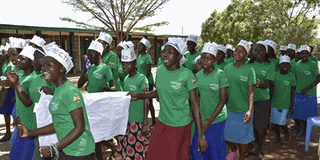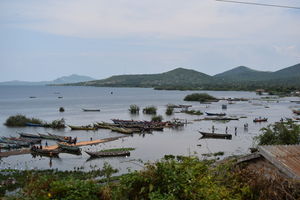Happening now: KCSE 2024: Education CS Julius Migos set to announce results
Use multi-sectorial approach to fight FGM, child marriages

Girls stage a performance after graduating from the Jukumu Letu program, which trains them on building self-confidence and protecting themselves against FGM and early marriages.
PHOTO | MILLICENT MWOLOLO | NATION MEDIA GROUP
Girls would be more at risk of child marriages and female genital mutilation (FGM) if the vices perpetrated consecutively are addressed separately.
This came out during Thursday’s discussions on Understanding the Relationship of between Child Marriage and Female Genital Mutilation at a webinar organised by United Nations Children’s Fund (Unicef)
Professor of medical anthropology at Autonomous University of Barcelona, Adriana Kaplan, noted the complexities of interrelations between both harmful practices with girls ending up suffering the most.
She observed that ending both vices collectively required a deeper understanding on how child marriage links to FGM and vice versa.
“For example in Senegal, FGM is done at different stages; they cut girls when they are babies and at pre-adolescence just before they are married off,” she said.
Unicef’s statistics and monitoring data and analytics, senior advisor, Claudia Cappa, identified ethnicity as a major factor that puts girls at higher risk of undergoing the cut and early marriage.
Generalised interventions
“Ethnicity is a significant variable because in certain ethnic groups, there is indeed concentration of both practices while in others the concentration doesn’t occur that much,” she said while referring to the entity’s unpublished data from a study interrogating the correlation between the two harmful practices.
She said girls from Samburu, Maasai and Somali ethnicities in Kenya were more likely to experience both harmful practices unlike those from Luo, Luhya and Turkana communities.
In this regard, the Unicef official advised against applying generalised anti-FGM and child marriage interventions as they would fail to deliver sustainable impacts.
“When we think of interventions, we really have to look at different ethnic groups as they don’t have similar patterns.”
Girls Not Brides, Head of Africa Engagement, Yvette Muhia, emphasised on adopting a multi-sectorial approach in which anti-FGM and child marriages stakeholders collaborate to end the vices collectively.
Communities, she said, should be put at the core of the multi-pronged approach to ensure they continue to protect the girls from the harmful practices.
“It is important to work with the communities to come up with monitoring and evaluation tools that they can adopt to establish a sustainable impact,” she said.





